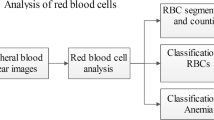Abstract
White blood cell (WBC) image detection plays an important role in automatic morphological systems since it can simplify and facilitate WBC segmentation and classification procedures. However, existing WBC detection methods mainly rely on the location of the nucleus, which is found difficult to achieve accurate detection results. This paper proposes a novel WBC detection algorithm through sliding windows with varying sizes to traverse the image for candidates. Three cues are explored to measure the candidates, and a combined cue is used as a single output to distinguish positives from negatives. The \(\epsilon \)-support vector regression is employed to determine the detection window from the candidates. In this paper, two applications of the proposed WBC detection approach are carried out, including an adaptive thresholding algorithm based on WBC detection for nucleus segmentation from images and target detection to lessen the users’ interaction for automatic cytoplasm segmentation.













Similar content being viewed by others
References
Sadeghian F, Seman Z, Ramli AR, Kahar BA, Saripan M-I (2009) A framework for white blood cell segmentation in microscopic blood images using digital image processing. Biol Proced Online 11(1):196–206
Rezatofighi SH, Soltanian-Zadeh H (2011) Automatic recognition of five types of white blood cells in peripheral blood. Comput Med Image Graph 35(4):333–343
Hiremath P, Bannigidad P, Geeta S (2010) Automated identification and classification of white blood cells (leukocytes) in digital microscopic images. Int J Comput Appl 2:59–63
Chinwaraphat S, Sanpanich A, Pintavirooj C, Sangworasil M, Tosranon P (2008) A modified fuzzy clustering for white blood cell segmentation. In: Proceeding of 3rd international symposium biomedical engineering, pp 356–359
Jiang K, Liao QM, Dai S-Y (2003) A novel white blood cell segmentation scheme using scale-space filtering and watershed clustering. In: Proceeding of international conference machine Learning cybernetics, vol 5, pp 2820–2825
Mohapatra S, Patra D, Kumar S, Satpathy S (2012) Lymphocyte image segmentation using functional link neural architecture for acute leukemia detection. Biomed Eng Lett 2(2):100–110
Putzu L, Caocci G, Di Ruberto C (2014) Leucocyte classification for leukaemia detection using image processing techniques. Artif Intell Med 62(3):179–191
Wu J, Zeng P, Zhou Y Olivier C (2006) A novel color image segmentation method and its application to white blood cell image analysis. In: Proceeding of 8th international conference of signal processing, vol 2
Ko BC, Gim JW, Nam J-Y (2011) Automatic white blood cell segmentation using stepwise merging rules and gradient vector flow snake. Micron 42(7):695–705
Pan C, Park DS, Yang Y (2012) Leukocyte image segmentation by visual attention and extreme learning machine. Neural Comput Appl 21(6):1217–1227
Cao F, Cai M, Chu J, Zhao J, Zhou Z (2016) A novel segmentation algorithm for nucleus in white blood cells based on low-rank representation. Neural Comput Appl. https://doi.org/10.1007/s00521-016-2391-8
Rezatofighi S, Soltanian-Zadeh H, Sharifia R, Zoroofi R (2009) A new approach to white blood cell nucleus segmentation based on Gram-Schmidt orthogonalization. In: Proceeding of international conference digital image processing, pp 107–111
Xu C, Prince JL (1998) Snakes, shapes, and gradient vector flow. IEEE Trans Image Process 7(3):359–369
Felzenszwalb P, Girshick R, McAllester D, Ramanan D (2010) Object detection with discriminatively trained part-based models. IEEE Trans Pattern Anal Mach Intell 32(9):1627–1645
Lampert CH, Blaschko M, Hofmann T (2008) Beyond sliding windows: object localization by efficient subwindow search. In: Proceeding of IEEE conference computer vision pattern recognition (CVPR), pp 1–8
Dalal N, Triggs B (2005) Histograms of oriented gradients for human detection. In: Proceeding of IEEE conference of computer vision pattern recognition (CVPR), vol 1, pp 886–893
Alexe B, Deselaers T, Ferrari V (2012) Measuring the objectness of image windows. IEEE Trans Pattern Anal Mach Intell 34(11):2189–2202
Alexe B, Deselaers T, Ferrari V (2010) What is an object? In: Proceeding of IEEE conference computer vision pattern recognition (CVPR), pp 73–80
Rother C, Kolmogorov V, Blake A (2004) Grabcut: interactive foreground extraction using iterated graph cuts. ACM Trans Graph (TOG) 23:309–314
Handin RI, Lux SE, Stossel TP (2003) Blood: principles and practice of hematology, vol 1. Lippincott Williams & Wilkins, Philadelphia
Canny J (1986) A computational approach to edge detection. IEEE Trans Pattern Anal Mach Intell 8(6):679–698
Vapnik VN (1998) Statistical learning theory, vol 2. Wiley, New York
Gonzalez R, Woods R (2008) Digital image processing. Pearson/Prentice Hall, Upper Saddle River
Di Ruberto C, Dempster A, Khan S, Jarra B (2002) Analysis of infected blood cell images using morphological operators. Image Vis Comput 20(2):133–146
Chang C-C, Lin C-J (2011) LIBSVM: a library for support vector machines. ACM Trans Intell Syst Technol 2:1–27
Chinchor N, Sundheim B (1993) Muc-5 evaluation metrics. In: Proceeding of 5th conference of message understanding, pp 69–78
Sasaki Y (2007) The truth of the f-measure. Teach Tut Mater Version
Tareef A, Song Y, Cai W, Wang Y, Feng DD, Chen M (2016) Automatic nuclei and cytoplasm segmentation of leukocytes with color and texture-based image enhancement. In: 13th IEEE international symposium on biomedical imaging, pp 935–938
Acknowledgements
This work is supported by the National Natural Science Foundation of China under Grant Nos. 61672477 and 61571410
Author information
Authors and Affiliations
Corresponding author
Ethics declarations
Conflict of interest
The authors declare that they have no conflict of interest.
Rights and permissions
About this article
Cite this article
Cao, F., Liu, Y., Huang, Z. et al. Effective segmentations in white blood cell images using \(\epsilon \)-SVR-based detection method. Neural Comput & Applic 31, 6767–6780 (2019). https://doi.org/10.1007/s00521-018-3480-7
Received:
Accepted:
Published:
Issue Date:
DOI: https://doi.org/10.1007/s00521-018-3480-7




